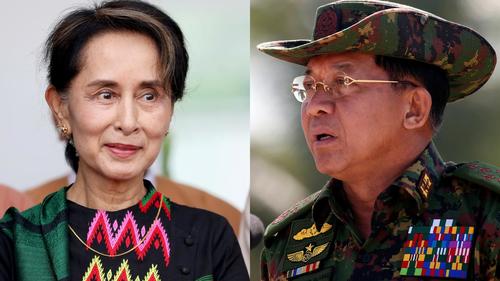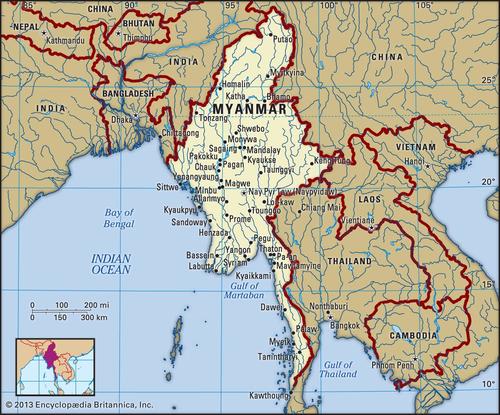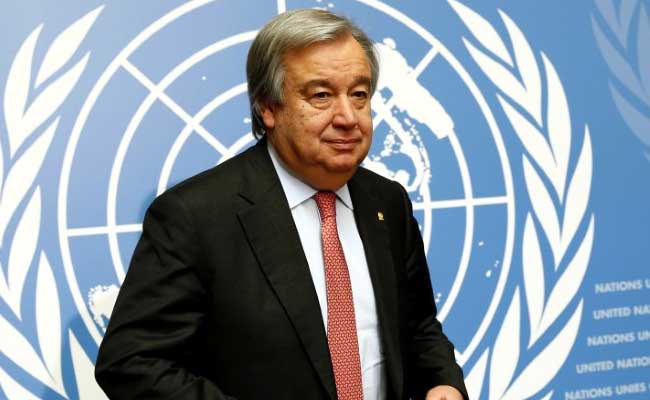The
extended border closures at Moreh, near the India-Myanmar border in
Manipur, have resulted in the loss of business for the approximately 200
shops tightly packed around the integrated check post on the Indian
side.
By Neha Banka
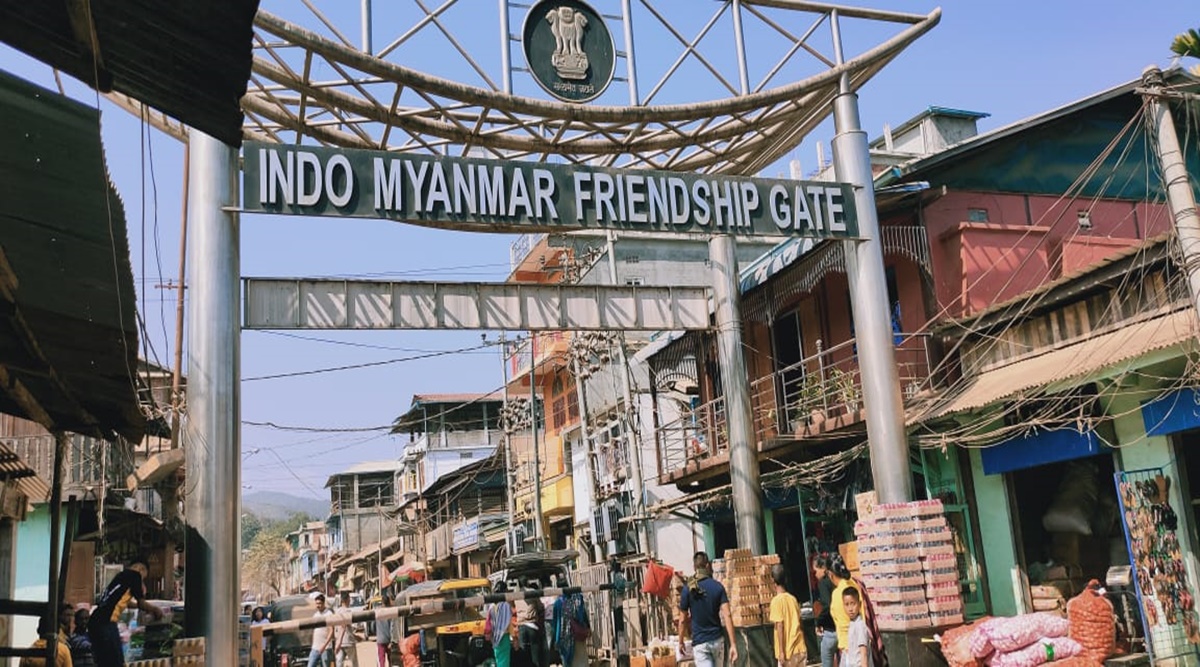
Moreh
is an important international border crossing and a major trade route
that connects South Asia, Southeast Asia and ASEAN economies. (Photo
credit: Sonboi)
Mohammad Faizal’s voice cracks with emotion as he begins to narrate his ordeal. Since March last year, after the coronavirus
outbreak led to a nationwide shutdown in India, the 48-year-old who
runs a grocery shop in Moreh, the last Indian town before the
international border between India and Myanmar, has struggled to make
ends meet.
 Mohammad Faizal sits outside his grocery shop located close to the
India-Myanmar border. The integrated check post on Indian territory is
visible behind him. (Photo credit: Sonboi)
Mohammad Faizal sits outside his grocery shop located close to the
India-Myanmar border. The integrated check post on Indian territory is
visible behind him. (Photo credit: Sonboi)
Just when Faizal had expected his financial troubles to ease, with
the proposed start of cross-border trade on February 1, Myanmar’s
military seized power on that very day, in a coup against the
democratically elected government of Nobel laureate Aung San Suu Kyi. In
early morning raids, Suu Kyi was detained along with other leaders of
her party. The international border gates at Moreh that were scheduled
to open on that day, remained closed.
In his small grocery shop that almost abuts the integrated check post
at the Indo-Myanmar border, Faizal sells everything from milk and rice
to vegetables and dried betel nuts. In the 20 years that he has run his
little business, he has never seen a situation this dire. “Don’t even
ask about what I am going through. Earlier I would earn Rs. 600 per day;
now I am earning almost nothing. I am eating using my savings,” he
says.
It is his three children for whom Faizal is most concerned. “For the past eight to nine months, I have only been feeding them dal and water.”
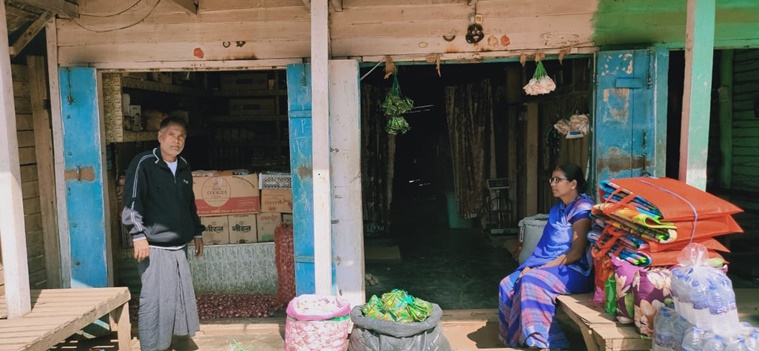 Mohammad Faizal stands inside his grocery shop located close to the
India-Myanmar border in Moreh, near the integrated check post on Indian
territory. His wife Ibema sits nearby, waiting for customers. (Photo
credit: Sonboi)
Mohammad Faizal stands inside his grocery shop located close to the
India-Myanmar border in Moreh, near the integrated check post on Indian
territory. His wife Ibema sits nearby, waiting for customers. (Photo
credit: Sonboi)
The extended border closures have resulted in the loss of business
for the approximately 200 shops tightly packed around the integrated
check post on the Indian side. According to these shopkeepers, after the
Indian government lifted several public health restrictions last year,
business had just started getting back on its feet. Then, the coup in
Myanmar brought everything to a screeching halt.
Moreh is an important international border crossing and a major trade route that connects South Asia, Southeast Asia and ASEAN
economies. In the region, Myanmar is an important trade partner and it
is also the only ASEAN country with whom India shares both a land and a
maritime boundary. Although seasonal agriculture provides income for
some residents, it is the international trade, a significant part of
which is illegal, that sustains Moreh’s local economy, according to a
2016 report by India’s Ministry of Commerce and Industry.
“Historically, unregulated trade has always existed between Manipur
and Myanmar through this border,” explains Dr Arambam Noni, Assistant
Professor, Department of Political Science, DM College of Arts, Imphal.
According to the 2016 report, border trade between India and Myanmar
stands at approximately $50 million, up from about $15 million in
2005-2006.
Bilateral trade between Indian and Myanmar is supported by New
Delhi’s 2010 free trade agreement with AESEAN nations. The trade of 62
designated items are at present allowed after the agreement was updated
in 2012.
Although official trade routes were closed following the coronavirus
outbreak in March last year, unregulated and illegal trade on a smaller
scale continued between Moreh and Tamu, the first border town in
Myanmar’s territory, till the coup occurred.
“Mostly only illegal trade happens along the India-Myanmar border.
The official trade is negligible in comparison,” says a source familiar
with the operations, requesting anonymity.
S. Saikhom has been running an electronics store in Moreh near the
integrated check post for some 15 years now, and would regularly travel
back and forth between India and Myanmar buying and selling products
before the gates closed. Everything has changed for small traders and
shop owners like him. “Things have become very expensive. Costs have
increased and there is a ban on transporting goods. The customers are
not coming,” he says.
In Moreh, the Indo-Myanmar Friendship Gate provides two points for
entry into Myanmar, Gate 1 and Gate 2, where the latter serves as the
informal entrance most frequently used by small traders and daily-wage
earners crossing the border every day. For 16 kilometers on either side
of the border, free movement without passports is permitted by both the
Indian and the Myanmar governments.
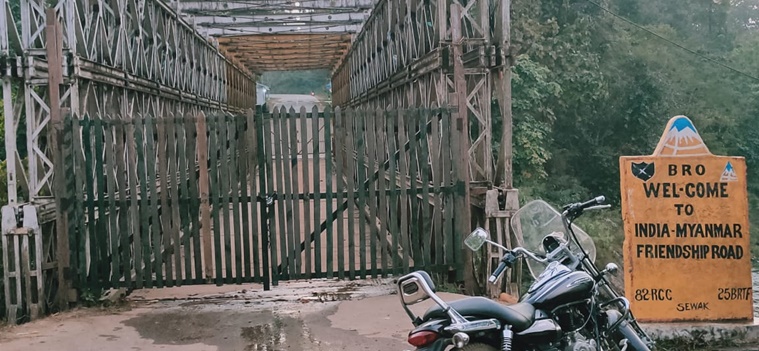 Gate 1 of the Indo-Myanmar Friendship Gate in Moreh, Manipur. At the
other end of the bridge is Myanmarese territory. (Photo credit: Sonboi)
Gate 1 of the Indo-Myanmar Friendship Gate in Moreh, Manipur. At the
other end of the bridge is Myanmarese territory. (Photo credit: Sonboi)
However, transporting medium to large sized items across the border
has never been easy, the shopkeepers say, as border guards would stop
them citing regulations. Now with Myanmar completely sealing its border,
movement has become impossible. “On some days, (Indian) security forces
would let us take one or two medium to large-sized goods across to
Myanmar and on other days they wouldn’t. What can we do?” asks one
shopkeeper in Moreh. “I am having a hard time paying my staff salaries
but I still have to, because otherwise how will they eat?”
But sources familiar with the operations at the border dismiss these
claims. “They don’t pay any taxes or customs duty. In the (free-trade)
agreement, there are provisions only for items that can be carried on
the head, but they try to pass everything through the borders,” the
source says.
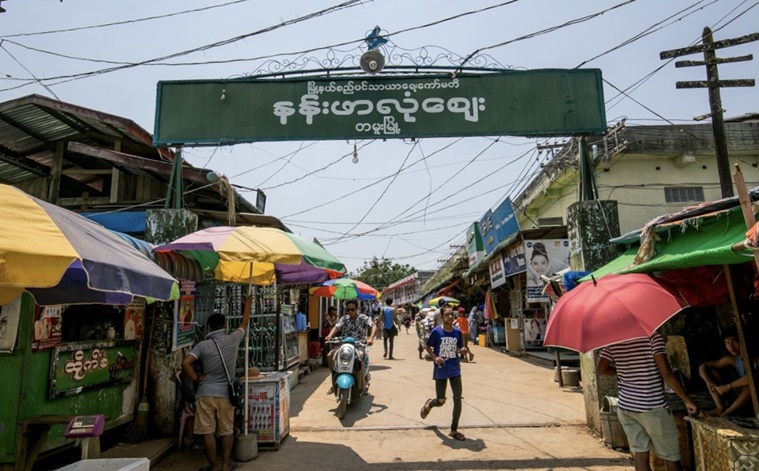 Namphalong market in Myanmar’s territory, is a five-minute rickshaw
ride from the integrated check post. Immediately upon entering the
marketplace, the signboard in green reads ‘Namphalong market, Tamu’ in
Burmese. In this file photo from 2019, the marketplace appears to be
visibly busy. Local shopkeepers attest that the scenario has changed
since March 2020, with no Indian customers and only a handful of local
shopkeepers. (Photo credit: Assad Dadan)
Namphalong market in Myanmar’s territory, is a five-minute rickshaw
ride from the integrated check post. Immediately upon entering the
marketplace, the signboard in green reads ‘Namphalong market, Tamu’ in
Burmese. In this file photo from 2019, the marketplace appears to be
visibly busy. Local shopkeepers attest that the scenario has changed
since March 2020, with no Indian customers and only a handful of local
shopkeepers. (Photo credit: Assad Dadan)
The scenario isn’t very different across the border in Myanmar. A
five-minute rickshaw ride from the integrated check post in Myanmar’s
territory is Namphalong market, which at first glance appears to be
almost an extension of the marketplace in Moreh. Tamu, the nearest
border town, is another 3 kilometers down the road.
While vendors selling everyday essentials like fruits, vegetables and
grains have returned to the marketplace in a trickle over the past few
months, it has been harder for shopkeepers like 27-year-old Khin Maung
Myint (name changed upon request). “Namphalong market is open but the
Indians are not coming,” he says during a phone interview, requesting
anonymity. Shopkeepers like him are entirely reliant on customers from
across the border, he says. “I have not opened my electronics shop in
almost one year. What can I say?”
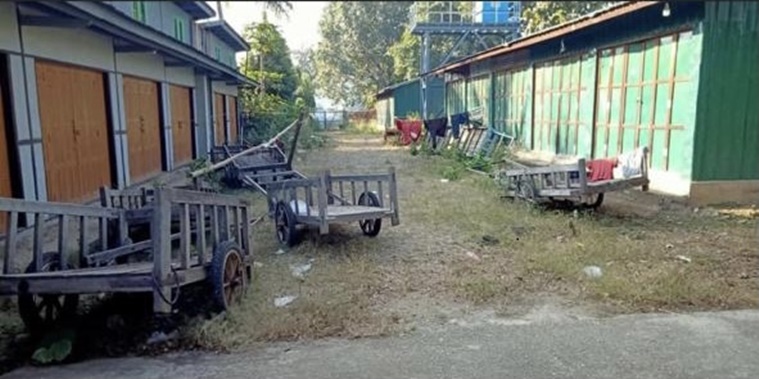 The empty marketplace in Namphalong. Shutters have been down since
March 2020 and shopkeepers have stayed away, mostly because there are no
customers from India. This photo was taken a few days ago but the
source was unable to confirm whether it was taken following the coup or
prior to it. Photo credit: Khin Maung Myint (name changed upon request)
The empty marketplace in Namphalong. Shutters have been down since
March 2020 and shopkeepers have stayed away, mostly because there are no
customers from India. This photo was taken a few days ago but the
source was unable to confirm whether it was taken following the coup or
prior to it. Photo credit: Khin Maung Myint (name changed upon request)
Namphalong market is a cluster of permanent and semi-permanent
structures where locals set up shop every day. Each unit is not larger
than 3×4 feet in width. “Goods are being sold across the border in India
using illegal routes and I am just about managing to run my household
through the income I earn from these kinds of sales,” admits Khin Maung
Myint. He doesn’t have a choice, he says; he has two parents, a wife and
two small children to look after.
 The empty marketplace in Namphalong, where shutters have been down
since March 2020. This photo was taken a few days ago but the source was
unable to confirm whether it was taken following the coup or prior to
it. Photo credit: Khin Maung Myint (name changed upon request)
The empty marketplace in Namphalong, where shutters have been down
since March 2020. This photo was taken a few days ago but the source was
unable to confirm whether it was taken following the coup or prior to
it. Photo credit: Khin Maung Myint (name changed upon request)
“My friends who have garment shops in Namphalong have nothing to
eat,” says Khin Maung Myint. Although the Myanmar government has been
distributing rice to residents in the area, it isn’t enough, he
explains.
Over the past year, his friends were forced to find alternate sources
of income that come with their own set of dangers. “In the dead of the
night, they smuggle clothes, cosmetics, things like that, across the
border in India. They are paid Rs. 250 to coolie—smuggle—these goods across,” he says of the porous borders between the two countries.
This “coolie work” is illegal, dangerous and difficult, but Myanmarese nationals living near the border here say they have little choice. “Coolie
work starts at 11 p.m. and goes on till 4 a.m.,” he says. They fear
getting caught by border forces, but they continue engaging in this kind
of work.
Officials familiar with smuggling and illegal trade operations at the
Indo-Myanmar border, requesting anonymity, told indianexpress.com that
despite the closure of the gates at Moreh and Tamu, illegal trade has
continued along the more porous sections of the borders between the two
countries. Security forces cannot be deployed for patrolling at all
points along the border, especially at night, and there are always
people on both sides of the border who manage to evade checks and border
guards.
 Significant sections of the Indo-Myanmar border are porous, that allow
people to pass through to the other side relatively easily, especially
in the darkness of the night. In this photograph, Myanmarese territory
lies on the other side of the barbed wire fence in Moreh, Manipur.
(Photo credit: Sonboi)
Significant sections of the Indo-Myanmar border are porous, that allow
people to pass through to the other side relatively easily, especially
in the darkness of the night. In this photograph, Myanmarese territory
lies on the other side of the barbed wire fence in Moreh, Manipur.
(Photo credit: Sonboi)
Community leaders on both sides of the border have urged their
respective governments for assistance, says Dr. Noni, but little has
changed. “Livelihood (for locals) hasn’t been secured and now the coup
has added more uncertainty. The Indian embassy in Myanmar has asked
Indian citizens to avoid unnecessary travel and it appears that it will
take time for the border to reopen.”
Security forces intensified vigil earlier this week along the 398
km-long Indo-Myanmar border in Manipur, following the coup in Myanmar.
“The impact of the coup is yet to be felt in the border areas in India,
but national security is of course a concern. It will be in national
interest if trade is completely stopped for a while. (Locals on both
sides of the border) have to understand the difference between illegal
and legal trade,” the source says.
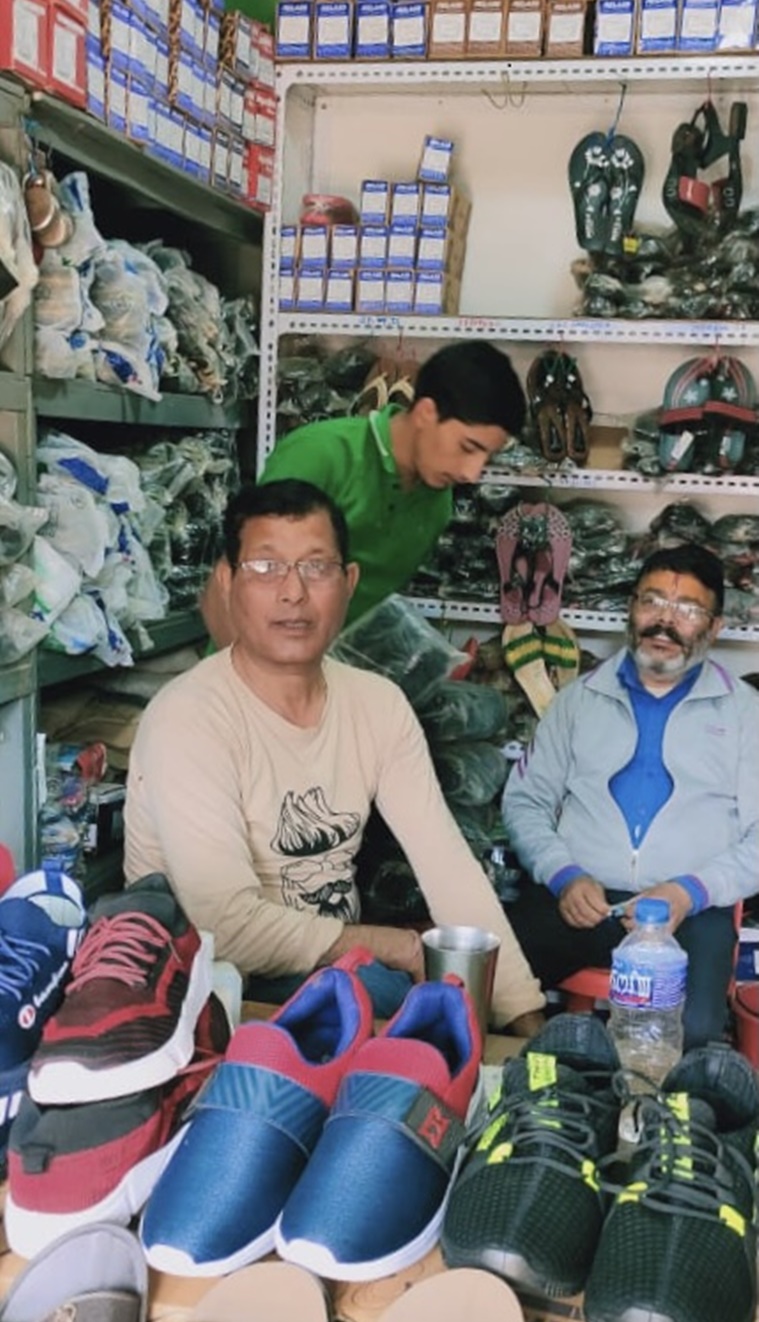 P.T. Adhikari sits surrounded by shoes and sandals in different colours
and styles in his shop located close to the India-Myanmar border in
Moreh, near the integrated check post on Indian territory. (Photo
credit: Sonboi)
P.T. Adhikari sits surrounded by shoes and sandals in different colours
and styles in his shop located close to the India-Myanmar border in
Moreh, near the integrated check post on Indian territory. (Photo
credit: Sonboi)
Unlike other shop owners around him, 60-year-old P. T. Adhikari sits
surrounded by shoes and sandals in different colours and styles, and is
less concerned about the closure of the borders and its impact on
cross-border unregulated trade. “I’m not worried. I’ll see what
happens,” he says.
A few doors down, despite his everyday worries, Mohammad Faizal is
hopeful. “Myanmar will solve its problem in one month.” Long-term
observers of Myanmar aren’t as certain that it will. But if and when the
border gates open, it is not clear whether it will be business as usual
for shopkeepers like Faizal, or whether the people of Moreh will see a
different Myanmar.





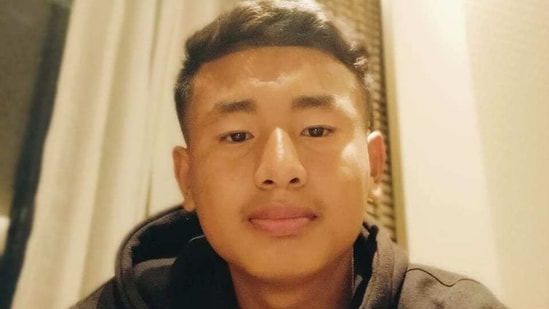

 Mohammad Faizal sits outside his grocery shop located close to the
India-Myanmar border. The integrated check post on Indian territory is
visible behind him. (Photo credit: Sonboi)
Mohammad Faizal sits outside his grocery shop located close to the
India-Myanmar border. The integrated check post on Indian territory is
visible behind him. (Photo credit: Sonboi) Mohammad Faizal stands inside his grocery shop located close to the
India-Myanmar border in Moreh, near the integrated check post on Indian
territory. His wife Ibema sits nearby, waiting for customers. (Photo
credit: Sonboi)
Mohammad Faizal stands inside his grocery shop located close to the
India-Myanmar border in Moreh, near the integrated check post on Indian
territory. His wife Ibema sits nearby, waiting for customers. (Photo
credit: Sonboi) Gate 1 of the Indo-Myanmar Friendship Gate in Moreh, Manipur. At the
other end of the bridge is Myanmarese territory. (Photo credit: Sonboi)
Gate 1 of the Indo-Myanmar Friendship Gate in Moreh, Manipur. At the
other end of the bridge is Myanmarese territory. (Photo credit: Sonboi) Namphalong market in Myanmar’s territory, is a five-minute rickshaw
ride from the integrated check post. Immediately upon entering the
marketplace, the signboard in green reads ‘Namphalong market, Tamu’ in
Burmese. In this file photo from 2019, the marketplace appears to be
visibly busy. Local shopkeepers attest that the scenario has changed
since March 2020, with no Indian customers and only a handful of local
shopkeepers. (Photo credit: Assad Dadan)
Namphalong market in Myanmar’s territory, is a five-minute rickshaw
ride from the integrated check post. Immediately upon entering the
marketplace, the signboard in green reads ‘Namphalong market, Tamu’ in
Burmese. In this file photo from 2019, the marketplace appears to be
visibly busy. Local shopkeepers attest that the scenario has changed
since March 2020, with no Indian customers and only a handful of local
shopkeepers. (Photo credit: Assad Dadan) The empty marketplace in Namphalong. Shutters have been down since
March 2020 and shopkeepers have stayed away, mostly because there are no
customers from India. This photo was taken a few days ago but the
source was unable to confirm whether it was taken following the coup or
prior to it. Photo credit: Khin Maung Myint (name changed upon request)
The empty marketplace in Namphalong. Shutters have been down since
March 2020 and shopkeepers have stayed away, mostly because there are no
customers from India. This photo was taken a few days ago but the
source was unable to confirm whether it was taken following the coup or
prior to it. Photo credit: Khin Maung Myint (name changed upon request) The empty marketplace in Namphalong, where shutters have been down
since March 2020. This photo was taken a few days ago but the source was
unable to confirm whether it was taken following the coup or prior to
it. Photo credit: Khin Maung Myint (name changed upon request)
The empty marketplace in Namphalong, where shutters have been down
since March 2020. This photo was taken a few days ago but the source was
unable to confirm whether it was taken following the coup or prior to
it. Photo credit: Khin Maung Myint (name changed upon request) Significant sections of the Indo-Myanmar border are porous, that allow
people to pass through to the other side relatively easily, especially
in the darkness of the night. In this photograph, Myanmarese territory
lies on the other side of the barbed wire fence in Moreh, Manipur.
(Photo credit: Sonboi)
Significant sections of the Indo-Myanmar border are porous, that allow
people to pass through to the other side relatively easily, especially
in the darkness of the night. In this photograph, Myanmarese territory
lies on the other side of the barbed wire fence in Moreh, Manipur.
(Photo credit: Sonboi) P.T. Adhikari sits surrounded by shoes and sandals in different colours
and styles in his shop located close to the India-Myanmar border in
Moreh, near the integrated check post on Indian territory. (Photo
credit: Sonboi)
P.T. Adhikari sits surrounded by shoes and sandals in different colours
and styles in his shop located close to the India-Myanmar border in
Moreh, near the integrated check post on Indian territory. (Photo
credit: Sonboi)